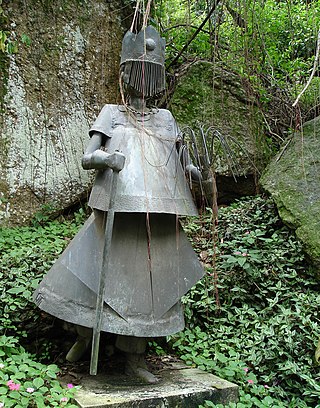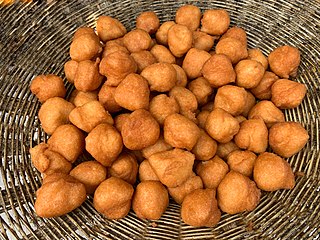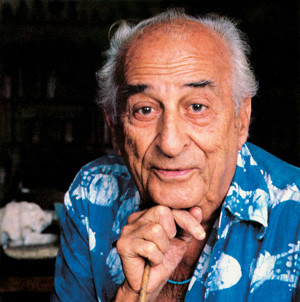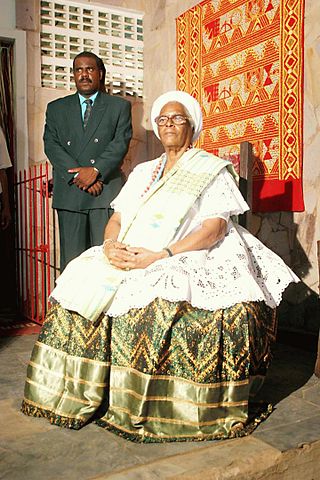
Ogun or Ogoun is a Yoruba spirit that appears in several African religions. He attempted to seize the throne after the demise of Ọbàtálá, who reigned twice, before and after Oduduwa, but was ousted by Obamakin and sent on an exile – an event that serves as the core of the Ọlọ́jọ́ Festival. Ògún is a warrior and a powerful spirit of metal work, as well as of rum and rum-making. He is also known as the "god of iron" and is present in Yoruba religion, Santería, Haitian Vodou, West African Vodun, and the folk religion of the Gbe people.

Shango is an Orisha in Yoruba religion. Genealogically speaking, Shango is a royal ancestor of the Yoruba as he was the third Alaafin of the Oyo Kingdom prior to his posthumous deification. Shango has numerous manifestations, including Airá, Agodo, Afonja, Lubé, and Obomin. He is known for his powerful double axe (Oṣè). He is considered to be one of the most powerful rulers that Yorubaland has ever produced.

Ọya is an Orisha of winds, lightning, and violent storms. As a river deity she is also regarded as a deity of children, able to provide children to her devotees or those who come to her banks at the Niger river.

Obatala is an orisha in the Yoruba religion that is believed to have been given the task to create the Earth but failed the task by being drunk on palm wine and was outperformed by his little brother Oduduwa. He was instead given the job of creating human beings. This was authorized by his father, Olodumare which gave Obatala the name sculptor of mankind.
"Now Olodumare [the supreme being] once called on Obatala and told him that he would love him to assist in creating human beings that would live in the world he was about to create. This is because as he (Olodumare) said further he would not like the world he was planning to create to exist without human beings."

Orishas are divine spirits that play a key role in the Yoruba religion of West Africa and several religions of the African diaspora that derive from it, such as Haitian Vaudou, Cuban, Dominican and Puerto Rican Santería and Brazilian Candomblé. The preferred spelling varies depending on the language in question: òrìṣà is the spelling in the Yoruba language, orixá in Portuguese, and orisha, oricha, orichá or orixá in Spanish-speaking countries.

Umbanda is a religion that emerged in Brazil in the 1920s. Deriving largely from Spiritism, it also combines elements from Afro-Brazilian traditions like Candomblé as well as Roman Catholicism. There is no central authority in control of Umbanda, which is organized around autonomous places of worship termed centros or terreiros, the followers of which are called Umbandistas.

Candomblé is an African diasporic religion that developed in Brazil during the 19th century. It arose through a process of syncretism between several of the traditional religions of West and Central Africa, mostly that of the Yoruba and some influence of Bantu, and Gbe, coupled with influences from Roman Catholicism. There is no central authority in control of Candomblé, which is organized around autonomous terreiros (houses).

Candomblé Ketu is the largest and most influential branch (nation) of Candomblé, a religion practiced primarily in Brazil. The word Candomblé means "ritual dancing or gather in honor of gods" and Ketu is the name of the Ketu region of Benin. Its liturgical language, known as yorubá or Nagô, is a dialect of Yoruba. Candomblé Ketu developed in the early 19th century and gained great importance to Brazilian heritage in the 20th century.

Axé is a popular music genre originated in Salvador, Bahia, Brazil in the 1980s, fusing different Afro-Caribbean genres, such as marcha, reggae, and calypso. It also includes influences of Brazilian music such as frevo, forró and carixada. The word Axé comes from the Yoruba term àṣẹ, meaning "soul, light, spirit or good vibrations". Axé is present in the Candomblé religion, as "the imagined spiritual power and energy bestowed upon practitioners by the pantheon of orixás". It also has ties with the Roman Catholic Church and the Lenten season, which represents the roots of Bahian Carnival.

Babalú-Aye, Oluaye, Ṣọpọna, Ayé in Trinidad Orisha, or Obaluaiye, is one of the orishas or manifestations of the supreme creator god Olodumare in the Yoruba religion of West Africa. Babalú-Aye is the spirit of the Earth and strongly associated with infectious disease, and healing.

Àkàrà (Yoruba) (English: bean cake; Hausa: kosai; Portuguese: acarajé is a type of fritter made from cowpeas or beans by the Yoruba people of Nigeria, Benin and Togo. It is found throughout West African, Caribbean, and Brazilian cuisines. The dish is traditionally encountered in Brazil's northeastern state of Bahia, especially in the city of Salvador. Acarajé serves as both a religious offering to the gods in the Candomblé religion and as street food. The dish was brought by enslaved Nigerian citizens from West Africa, and can still be found in various forms in Nigeria, Benin and Togo.

Héctor Julio Páride Bernabó was an Argentine-Brazilian artist, researcher, writer, historian and journalist. His nickname and artistic name, Carybé, a type of piranha, comes from his time in the scouts. He died of heart failure after the meeting of a candomblé community's lay board of directors, the Cruz Santa Opô Afonjá Society, of which he was a member.

Santería, also known as Regla de Ocha, Regla Lucumí, or Lucumí, is an Afro-Caribbean religion that developed in Cuba during the late 19th century. It arose amid a process of syncretism between the traditional Yoruba religion of West Africa, the Roman Catholic form of Christianity, and Spiritism. There is no central authority in control of Santería and much diversity exists among practitioners, who are known as creyentes ("believers").

Oko, also known as Ocô in Brazil, was an Orisha. In Nigeria and the Benin Republic, he was a strong hunter and farming deity, as well as a fighter against sorcery. He was associated with the annual new harvest of the white African yam. Among the deities, he was considered a close friend of Oosa, Ogiyan and Shango, as well as a one-time husband of Oya and Yemoja. Bees are said to be the messengers of Oko.

Yemọja is the major water spirit from the Yoruba religion. She is the mother of all Orishas. She is also the mother of humanity. She is an orisha, in this case patron spirit of rivers, particularly the Ogun River in Nigeria, and oceans in Cuban and Brazilian orisa religions. She is often syncretized with either Our Lady of Regla in the Afro-Cuban diaspora or various other Virgin Mary figures of the Catholic Church, a practice that emerged during the era of the Trans-Atlantic slave trade. Yemọja is said to be motherly and strongly protective, and to care deeply for all her children, comforting them and cleansing them of sorrow. She is said to be able to cure infertility in women, and cowrie shells represent her wealth. She does not easily lose her temper, but when angered she can be quite destructive and violent, as the flood waters of turbulent rivers. Some of the priests of Yemọja believe that she used her fresh water to help Ọbàtálá in the molding of human beings out of clay.
Mãe Menininha do Gantois also known as Mother Menininha do Gantois, was a Brazilian spiritual leader (iyalorixá) and spiritual daughter of orixá Oxum, who officiated for 64 years as the head of one of the most noted Candomblé temples, the Ilê Axé Iyá Omin Iyamassê, or Terreiro do Gantois, of Brazil, located in Alto do Gantois in Salvador, Bahia. She was instrumental in gaining legal recognition of Candomblé and its rituals, bringing an end to centuries of prejudice against Afro-Brazilians, who practiced their faith. When she died on 13 August 1986, the State of Bahia declared a three-day state mourning in her honour, and the City Council of Salvador held a special session to pay tributes to her. The Terreiro do Gantois temple has been declared a protected national monument.

Ilê Axé Opô Afonjá Axé Iyá Nassô Oká is a historic Candomblé temple in the city of Salvador, Bahia, in northeastern Brazil. It is also known as the Casa Branca do Engenho Velho, or simply the Casa Branca. Located on a hill above Vasco da Gama, a busy avenue in the working-class neighborhood of Engenho Velho, the terreiro belongs to the Ketu branch of Candomblé, which is heavily influenced by the religious beliefs and practices of the Yoruba people. The earliest documents proving the temple's existence are from the late nineteenth century, but it was certainly founded much earlier, probably c. 1830. Since the 1940s, the religious community has been registered as a public entity under the name Sociedade Beneficente e Recreativa São Jorge do Engenho Velho.

Acaçá is a ritual food central to ceremonies of Afro-Brazilian religions, specifically to Candomblé rituals. It is found in the states of Bahia, Pernambuco, Rio Grande do Sul, and Rio de Janeiro. Pai Cido de Osun Eyin stated that "life [...] is sustained, and is renewed with the ritual offering of acaçá." It has at least two variations: a similar dish made of black beans and a drink also used in Candomblé rituals.

Mãe Stella de Oxóssi was a iyalorixá, or priestess, in the Brazilian Candomblé religion. She was the fifth iyalorixá of Ilê Axé Opô Afonjá, a Candomblé terreiro in Salvador, Bahia, Brazil. Mãe Stella was trained as a public health nurse. She was initiated into the Candomblé religion in 1939 and became the iyalorixá of Ilê Axé Opô Afonjá in 1976. Mãe Stella is noted for writing on the beliefs and practices of Candomblé for the general public, rather than practitioners. She lived in the interior of Bahia after a stroke and was interred in Salvador after her death in 2018.

Afro-Brazilian culture is the combination of cultural manifestations in Brazil that have suffered some influence from African culture since colonial times until the present day. Most of Africa's culture reached Brazil through the transatlantic slave trade, where it was also influenced by European and indigenous cultures, which means that characteristics of African origin in Brazilian culture are generally mixed with other cultural references.




















